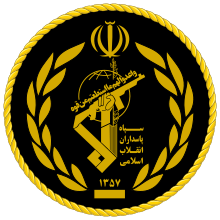8th Najaf Ashraf Division
| 8th Najaf Ashraf Division | |
|---|---|
| لشکر 8 نجف اشرف | |
| Country |
|
| Branch | Army of the Guardians of the Islamic Revolution |
| Size | Division |
| Garrison/HQ | Isfahan Province |
| Nickname(s) | "Najaf Ashraf" (نجف اشرف) |
| Engagements | Iran–Iraq War |
| Commanders | |
| Notable commanders |
Ahmad Kazemi Mehdi Bakeri (deputy) |
8th Najaf Ashraf Division (Persian: لشکر 8 نجف اشرف) is a division of the Army of the Guardians of the Islamic Revolution.
It was first officially organized as the 8th Najaf Ashraf Brigade (Persian: تیپ 8 نجف اشرف) during Iran-Iraq war, just after Operation Samen-ol-A'emeh. Initially, its fighters were mostly from the Najafabad County, Isfahan Province. The brigade was organized and nicknamed "Najaf Ashraf" by Ahmad Kazemi, which was appointed as its commander by Gholam Ali Rashid. Kazemi asked Mehdi Bakeri to become his deputy, after which forces from Azarbaijan Province and Zanjan Province also joined the unit. When Bakeri became the commander of the 31st Ashura Division, these forces joined the latter. Later, forces from Yazd Province also established their own unit, the 18th Al-Ghadir Brigade, and split from the Najaf Division. With the establishment of the 44th Qamar-e Bani-Hashem Brigade, forces from Kohgiluyeh and Boyer-Ahmad Province and Isfahan Province also left the Najaf Division.[1][2]
In Operation Beit-ol-Moqaddas, the Najaf Ashraf Brigade was the unit which first broke into Khorramshahr, capturing thausands of Iraqi soldiers.
It was reportedly the first IRGC division to establish an armored unit, using the captured Iraqi armor.[1] The division is also called 8th Najaf Ashraf Armored Division.
References
- 1 2 "Division 8 Najaf : How was formed". Sahebnews.ir. 2016-10-16. Retrieved 2016-11-16.
- ↑ چاپلینک ثابتسطح یگان; یگان مستقل. "لشکر 8 نجف | دفاعمقدس". Defamoghaddas.ir (in (Persian)). Retrieved 2016-11-16.
